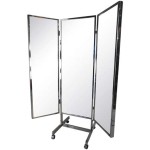Spray Painting a Plastic Mirror Frame: A Comprehensive Guide
Spray painting a plastic mirror frame is a cost-effective and relatively simple method to update its appearance and integrate it seamlessly into a specific décor. Instead of purchasing a new mirror, a fresh coat of paint can transform an outdated or mismatched frame into a stylish accent piece. This process, however, requires careful preparation and execution to achieve a professional-looking and durable finish. The following guide provides a detailed explanation of the steps involved in spray painting a plastic mirror frame, ensuring a successful outcome.
The success of any spray painting project hinges on thorough preparation. Neglecting this crucial stage can result in paint adhesion problems, uneven coverage, and a less-than-desirable final product. Adequate preparation involves cleaning, sanding, and priming the plastic surface to create an optimal foundation for the topcoat of paint.
Key Point 1: Preparing the Plastic Frame for Painting
The initial step involves cleaning the plastic mirror frame. Use a mild detergent, such as dish soap diluted in warm water, to remove any dirt, grease, oils, or other contaminants that may be present on the surface. A soft cloth or sponge should be used to gently scrub the frame, paying particular attention to corners and crevices where grime tends to accumulate. Rinse the frame thoroughly with clean water and allow it to air dry completely. Ensure the frame is completely dry before proceeding to the next step. Any moisture trapped beneath the paint can cause blistering or peeling.
Once the frame is dry, the next step is sanding. Plastic surfaces are typically smooth, which can hinder paint adhesion. Sanding creates microscopic scratches that provide the paint with more "tooth" to grip onto. Use a fine-grit sandpaper, typically between 220 and 320 grit, for this purpose. Avoid using coarse-grit sandpaper, as it can leave deep scratches that are difficult to conceal. Lightly sand the entire surface of the frame, focusing on areas where the surface is particularly smooth or glossy. Apply consistent pressure while sanding to ensure an even distribution of scratches. After sanding, use a tack cloth or a damp cloth to remove any sanding dust. This step is critical to prevent dust particles from being trapped beneath the paint, which can result in a bumpy or uneven finish.
Priming is an essential step in preparing a plastic mirror frame for painting. Primer acts as a bonding agent, improving the adhesion of the paint to the plastic surface and preventing the paint from peeling or chipping. Select a primer specifically formulated for use on plastic. These primers are designed to adhere effectively to plastic surfaces and provide a stable base for the topcoat. Apply the primer in thin, even coats, holding the spray can approximately 8-10 inches away from the frame. Overlapping each pass slightly ensures complete coverage. Allow the primer to dry completely according to the manufacturer's instructions. Depending on the type of primer used, this may take several hours or even overnight. After the primer has dried, inspect the surface for any imperfections. If necessary, lightly sand any rough spots or drips with fine-grit sandpaper and then wipe away the dust with a tack cloth before proceeding to the next stage.
Key Point 2: Selecting the Appropriate Paint and Applying it Effectively
Choosing the right paint for a plastic mirror frame is crucial for achieving a durable and aesthetically pleasing finish. Acrylic-based spray paints are generally recommended for plastic surfaces due to their flexibility and adhesion properties. These paints are less likely to crack or chip when the plastic expands or contracts with temperature changes. Avoid using solvent-based paints, as they can damage or melt the plastic. Consider the desired finish when selecting the paint. Options include matte, satin, semi-gloss, and gloss. Matte finishes provide a non-reflective and subtle look, while gloss finishes offer a high-shine and durable surface. Satin and semi-gloss finishes fall somewhere in between, providing a moderate level of sheen.
Before painting the mirror frame, ensure adequate ventilation in the work area. Spray painting should ideally be done outdoors, but if that is not possible, a well-ventilated room is essential. Cover the surrounding area with drop cloths or newspaper to protect it from overspray. Wear a respirator mask to avoid inhaling paint fumes and gloves to protect the hands. Shake the spray paint can vigorously for at least one minute before use to ensure the paint is properly mixed. Hold the can approximately 8-10 inches away from the frame and apply the paint in thin, even coats. Use a smooth, sweeping motion, overlapping each pass slightly. Avoid applying too much paint in one coat, as this can lead to drips and runs. Multiple thin coats are preferable to one thick coat. Allow each coat to dry completely before applying the next. The drying time will vary depending on the type of paint used and the ambient temperature and humidity. Refer to the manufacturer's instructions for specific drying times.
Inspect the frame after each coat has dried. If any drips or runs are present, use fine-grit sandpaper to gently sand them down. Wipe away the sanding dust with a tack cloth before applying the next coat. Typically, two to three coats of paint are sufficient to achieve full coverage and a uniform finish. However, depending on the color and opacity of the paint, more coats may be necessary. Ensure that each coat is completely dry before applying the next to prevent the paint from becoming tacky or smudged.
For added protection and durability, consider applying a clear coat sealant after the paint has fully dried. A clear coat sealant will help to protect the paint from scratches, chips, and fading, and it will also enhance the overall appearance of the frame. Apply the clear coat in the same manner as the paint, using thin, even coats and allowing each coat to dry completely before applying the next. Choose a clear coat sealant that is compatible with the type of paint used. Both acrylic and polyurethane clear coats are common choices for plastic surfaces. Again, consult the manufacturer's instructions for specific drying times and application guidelines.
Key Point 3: Additional Considerations and Troubleshooting
Masking is a critical technique when spray painting a mirror frame, especially if the mirror itself needs to be protected from overspray. Use painter's tape to carefully mask off the mirror glass along the edges of the frame. Apply the tape firmly to ensure a tight seal and prevent paint from seeping underneath. Multiple layers of tape can provide extra protection. In addition to painter's tape, consider using plastic sheeting or newspaper to cover the entire mirror surface. This will provide a comprehensive barrier against overspray and prevent any accidental paint splatters from damaging the mirror.
Even with careful preparation and execution, minor imperfections can sometimes occur during the spray painting process. Drips and runs are a common problem, especially when applying too much paint in one coat. If drips or runs occur, allow the paint to dry completely before attempting to fix them. Once dry, use fine-grit sandpaper to gently sand down the drips or runs until the surface is smooth. Wipe away the sanding dust with a tack cloth and then apply a thin coat of paint to the affected area. Repeat this process if necessary until the imperfection is completely removed.
Orange peel is another common issue that can arise during spray painting. Orange peel refers to a textured surface that resembles the skin of an orange. This can be caused by several factors, including improper spray technique, using the wrong type of paint, or applying the paint in conditions that are too hot or too humid. To prevent orange peel, hold the spray can at the correct distance from the surface and use a smooth, even motion. Ensure that the paint is properly mixed and that the ambient temperature and humidity are within the recommended range for the paint being used. If orange peel does occur, it can be corrected by wet sanding the surface with fine-grit sandpaper and then applying a fresh coat of paint.
Proper disposal of used spray paint cans is important for environmental reasons. Most spray paint cans are considered hazardous waste and should not be disposed of in regular trash. Check with local authorities or waste management services for information on how to properly dispose of used spray paint cans in the area. Many communities offer hazardous waste collection programs or drop-off locations where spray paint cans can be safely disposed of.
Following these guidelines will increase the likelihood of a successful outcome when spray painting a plastic mirror frame. Attention to preparation, paint selection, application technique, and troubleshooting will all contribute to a professional and long-lasting finish, transforming an outdated object into a refreshed and personalized decorative piece.

How To Spray Paint A Mirror Frame Perfect Beginner Diy Project Design Morsels

Spray Painted Gold Yard Mirror How To Paint A Frame

Spray Painted Rainbow Mirror Makeover Colorshot Paint

How To Spray Paint A Mirror Frame Perfect Beginner Diy Project Design Morsels

Spray Paint A Mirror Frame

999 Request Failed Crafts Painting Plastic

How To Paint Plastic Mirror Decorative Inspirations

How To Paint A Mirror Frame

How To Paint Plastic Mirror Decorative Inspirations

How To Spray Paint A Mirror Step By Guide








